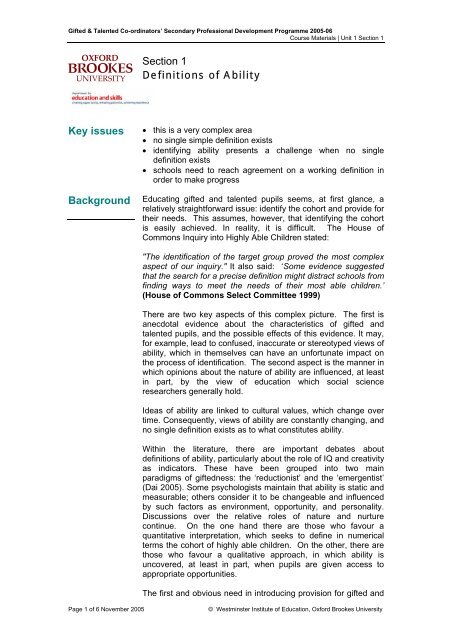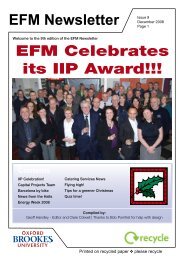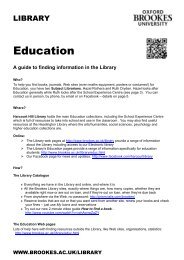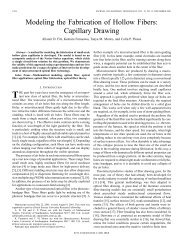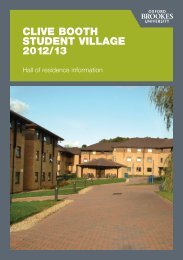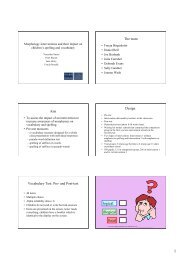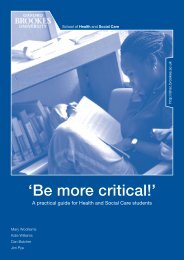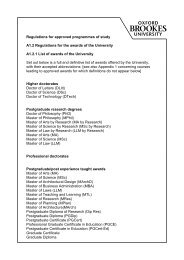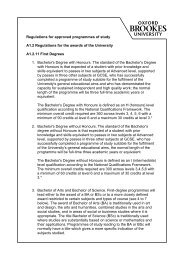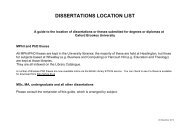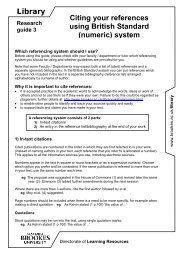Section 1 Definitions of Ability Key issues - Oxford Brookes University
Section 1 Definitions of Ability Key issues - Oxford Brookes University
Section 1 Definitions of Ability Key issues - Oxford Brookes University
You also want an ePaper? Increase the reach of your titles
YUMPU automatically turns print PDFs into web optimized ePapers that Google loves.
Gifted & Talented Co-ordinators’ Secondary Pr<strong>of</strong>essional Development Programme 2005-06<br />
Course Materials | Unit 1 <strong>Section</strong> 1<br />
<strong>Key</strong> <strong>issues</strong><br />
Background<br />
<strong>Section</strong> 1<br />
<strong>Definitions</strong> <strong>of</strong> <strong>Ability</strong><br />
• this is a very complex area<br />
• no single simple definition exists<br />
• identifying ability presents a challenge when no single<br />
definition exists<br />
• schools need to reach agreement on a working definition in<br />
order to make progress<br />
Educating gifted and talented pupils seems, at first glance, a<br />
relatively straightforward issue: identify the cohort and provide for<br />
their needs. This assumes, however, that identifying the cohort<br />
is easily achieved. In reality, it is difficult. The House <strong>of</strong><br />
Commons Inquiry into Highly Able Children stated:<br />
"The identification <strong>of</strong> the target group proved the most complex<br />
aspect <strong>of</strong> our inquiry." It also said: ‘Some evidence suggested<br />
that the search for a precise definition might distract schools from<br />
finding ways to meet the needs <strong>of</strong> their most able children.’<br />
(House <strong>of</strong> Commons Select Committee 1999)<br />
There are two key aspects <strong>of</strong> this complex picture. The first is<br />
anecdotal evidence about the characteristics <strong>of</strong> gifted and<br />
talented pupils, and the possible effects <strong>of</strong> this evidence. It may,<br />
for example, lead to confused, inaccurate or stereotyped views <strong>of</strong><br />
ability, which in themselves can have an unfortunate impact on<br />
the process <strong>of</strong> identification. The second aspect is the manner in<br />
which opinions about the nature <strong>of</strong> ability are influenced, at least<br />
in part, by the view <strong>of</strong> education which social science<br />
researchers generally hold.<br />
Ideas <strong>of</strong> ability are linked to cultural values, which change over<br />
time. Consequently, views <strong>of</strong> ability are constantly changing, and<br />
no single definition exists as to what constitutes ability.<br />
Within the literature, there are important debates about<br />
definitions <strong>of</strong> ability, particularly about the role <strong>of</strong> IQ and creativity<br />
as indicators. These have been grouped into two main<br />
paradigms <strong>of</strong> giftedness: the ‘reductionist’ and the ‘emergentist’<br />
(Dai 2005). Some psychologists maintain that ability is static and<br />
measurable; others consider it to be changeable and influenced<br />
by such factors as environment, opportunity, and personality.<br />
Discussions over the relative roles <strong>of</strong> nature and nurture<br />
continue. On the one hand there are those who favour a<br />
quantitative interpretation, which seeks to define in numerical<br />
terms the cohort <strong>of</strong> highly able children. On the other, there are<br />
those who favour a qualitative approach, in which ability is<br />
uncovered, at least in part, when pupils are given access to<br />
appropriate opportunities.<br />
The first and obvious need in introducing provision for gifted and<br />
Page 1 <strong>of</strong> 6 November 2005 © Westminster Institute <strong>of</strong> Education, <strong>Oxford</strong> <strong>Brookes</strong> <strong>University</strong>
Gifted & Talented Co-ordinators’ Secondary Pr<strong>of</strong>essional Development Programme 2005-06<br />
Course Materials | Unit 1 <strong>Section</strong> 1<br />
Examples <strong>of</strong><br />
definitions<br />
talented pupils is to identify those pupils who should receive<br />
targeted provision. This process can be seriously hampered if<br />
staff are using a range <strong>of</strong> personal definitions <strong>of</strong> ability which<br />
conflict with one another.<br />
Although schools can not be expected to resolve longstanding<br />
dilemmas about definition, they can arrive at a working definition<br />
that, on the one hand, is informed by the debate in the field and,<br />
on the other, reflects the school ethos. Establishing a working<br />
definition is not an end in itself, but rather the first step in creating<br />
a broad, workable consensus that leads to effective provision for<br />
gifted and talented pupils. Indeed, the process <strong>of</strong> discussion is<br />
arguably as important as the final definition, if the aim is to raise<br />
staff awareness and bring about pr<strong>of</strong>essional development and<br />
confidence in providing for these pupils.<br />
A school-wide definition is also an essential management and<br />
monitoring tool that enables resources to be equitably assigned<br />
and progress efficiently tracked. The co-ordinator’s role is to<br />
facilitate the debate, to act as the school’s ‘resident expert’ and<br />
to enable the school to reach its own answer to the question<br />
‘Who are the gifted and talented in our school?’<br />
Studies have shown that many schools experience a ‘gifted and<br />
talented journey’ in which the definition and identification <strong>of</strong> high<br />
ability becomes increasingly sophisticated and broad-based.<br />
(Ofsted 2001: Nord Anglia Research Project 2001: HMI<br />
2003).This is also borne out by research from <strong>Oxford</strong> <strong>Brookes</strong><br />
<strong>University</strong> (Haight 2005).<br />
Below are eight definitions taken from the literature. You may<br />
wish to reflect on them and then carry out the boxed task at the<br />
end <strong>of</strong> this section.<br />
‘Giftedness is asynchronous development in which<br />
advanced cognitive abilities and heightened intensity<br />
combine to create inner experiences and awareness that are<br />
qualitatively different from the norm. This asynchrony<br />
increases with higher intellectual capacity. The uniqueness<br />
<strong>of</strong> the gifted renders them particularly vulnerable and<br />
requires modifications in parenting, teaching and counselling<br />
in order for them to develop optimally.’ (The Columbus<br />
Group, 1991)<br />
‘A gifted pupil is one who demonstrates a significantly higher<br />
level <strong>of</strong> ability than most pupils <strong>of</strong> the same age in one or<br />
more curriculum areas or in any <strong>of</strong> the following:<br />
• physical talent<br />
• artistic talent<br />
• mechanical ingenuity<br />
• leadership<br />
• high intelligence<br />
• creativity<br />
(Eric Ogilvie, 1973)’<br />
(Marston Middle School policy, quoted in Eyre, 1997: 145)<br />
Page 2 <strong>of</strong> 6 November 2005 © Westminster Institute <strong>of</strong> Education, <strong>Oxford</strong> <strong>Brookes</strong> <strong>University</strong>
Gifted & Talented Co-ordinators’ Secondary Pr<strong>of</strong>essional Development Programme 2005-06<br />
Course Materials | Unit 1 <strong>Section</strong> 1<br />
’We will always have several conceptions (and therefore<br />
definitions) <strong>of</strong> giftedness…Schoolhouse giftedness might<br />
also be called test-taking or lesson-learning<br />
giftedness….Creative-productive giftedness describes those<br />
aspects <strong>of</strong> human activity and involvement where a premium<br />
is placed on the development <strong>of</strong> original material and<br />
products that are purposefully designed to have an impact<br />
on one or more target audiences.’ (Renzulli, 2003: 9-10)<br />
‘Children and youth with outstanding talent perform or show<br />
the potential for performing at remarkably high levels <strong>of</strong><br />
accomplishment when compared with others <strong>of</strong> their age,<br />
experience, or environment. These children and youth exhibit<br />
high performance capability in the intellectual, creative,<br />
and/or artistic areas, possess an unusual leadership<br />
capacity, or excel in specific academic fields. . . Outstanding<br />
talents are present in children and youth from all cultural<br />
backgrounds, across all economic strata, and in all areas <strong>of</strong><br />
human endeavour.’ (US Department <strong>of</strong> Education, 1993)<br />
The pentagonal theory <strong>of</strong> giftedness identifies five criteria that<br />
are ‘individually necessary and jointly sufficient for a student<br />
to be identified as gifted’:<br />
• Excellence: superior in some dimension or set <strong>of</strong><br />
dimensions<br />
• Rarity: the excellence must be relative to peers<br />
• Demonstrability: shown through at least one valid test<br />
• Productivity: the dimension must lead to or potentially<br />
lead to productivity<br />
• Value: the superior performance must be valued by the<br />
student’s society. (adapted from Zhang and Hui, 2001:<br />
78, paraphrasing Sternberg and Zhang, 1995)<br />
‘[T]he cohort <strong>of</strong> highly able children equates roughly to the<br />
top 2 per cent <strong>of</strong> children as measured by standardised tests.<br />
That is to say that children with a measured cognitive ability<br />
two standard deviations above the mean (approximately IQ<br />
130 and above) might be considered highly able.’ (One <strong>of</strong><br />
many definitions considered by the House <strong>of</strong> Commons,<br />
1999: 69-70)<br />
‘Intelligence in this context is defined as being the ability to<br />
comprehend, absorb and manipulate knowledge in both<br />
modes (ie synthesis and analysis). It does not have to be, <strong>of</strong><br />
necessity, evident in a purely academic form.’ (House <strong>of</strong><br />
Commons, 1999: 58)<br />
‘Multiple Intelligences:<br />
• logical-mathematical: the ability to detect patterns, think<br />
logically, reason deductively and carry out mathematical<br />
operations<br />
• linguistic: mastery <strong>of</strong> spoken or written language to express<br />
oneself or remember things<br />
• spatial: the potential for recognizing and manipulating<br />
patterns <strong>of</strong> both wide spaces (pilots, navigators) and<br />
confined spaces (sculptors, architects, chess players)<br />
Page 3 <strong>of</strong> 6 November 2005 © Westminster Institute <strong>of</strong> Education, <strong>Oxford</strong> <strong>Brookes</strong> <strong>University</strong>
Gifted & Talented Co-ordinators’ Secondary Pr<strong>of</strong>essional Development Programme 2005-06<br />
Course Materials | Unit 1 <strong>Section</strong> 1<br />
Activity 1.1<br />
Learning<br />
outcomes<br />
Either<br />
• musical: the capacity to recognize and compose musical<br />
pitches, tones, rhythms, and patterns and use them for<br />
performance or composition<br />
• bodily-kinaesthetic: using parts <strong>of</strong> the body or the whole<br />
body to solve problems or create products<br />
• interpersonal: the ability to recognize the intentions,<br />
feelings and motivations <strong>of</strong> others<br />
• intrapersonal: the ability to understand oneself and use that<br />
information to regulate one’s own life<br />
• naturalistic: the ability to recognize and classify the<br />
numerous species – the flora and fauna – in the<br />
environment’ (adapted from Plucker, 2001, paraphrasing<br />
Gardner, 1999).<br />
� Choose a small sample from the set <strong>of</strong> definitions<br />
above.<br />
� Use them in school to seek reactions from your<br />
colleagues.<br />
� Try to arrive at a working definition for your school,<br />
drawn from elements within these (or other<br />
descriptions <strong>of</strong> giftedness you have encountered).<br />
Many co-ordinators have found it useful to form a<br />
working party to steer the whole-school<br />
discussion. This is particularly effective where<br />
each subject department is represented in its<br />
membership.<br />
� Are your ‘talented’ pupils catered for in your<br />
working definition?<br />
� Or:<br />
� Consider how you will refine/amend your definition<br />
in the light <strong>of</strong> experience or changing needs. Take<br />
notes that will help you achieve this.<br />
• Recognise that no single definition <strong>of</strong> ability exists<br />
• Establish a working definition for your school which is shared<br />
by the whole school community<br />
• Reflect on your role as co-ordinator in this process<br />
Page 4 <strong>of</strong> 6 November 2005 © Westminster Institute <strong>of</strong> Education, <strong>Oxford</strong> <strong>Brookes</strong> <strong>University</strong>
Gifted & Talented Co-ordinators’ Secondary Pr<strong>of</strong>essional Development Programme 2005-06<br />
Course Materials | Unit 1 <strong>Section</strong> 1<br />
References Columbus Group (1991) Available from Hoagies’ Gifted<br />
Education Page: http://www.hoagiesgifted.org/<br />
Dai. D. Y. (2005) ‘Reductionism versus Emergentism: A<br />
framework for understanding conceptions <strong>of</strong> giftedness’ Roeper<br />
Review (Spring 2005) vol 27, no. 3, pp. 144-151.<br />
Eyre, D. (1997) Able Children in Ordinary Schools. London:<br />
David Fulton/Nace.<br />
Gardner, H. (1993) Frames <strong>of</strong> Mind: the theory <strong>of</strong> multiple<br />
intelligences (2 nd edn) London: Fontana Press.<br />
Haight, A. (2005) ‘Inclusiveness and teacher attitudes in the<br />
identification <strong>of</strong> gifted and talented pupils in Excellence in Cities<br />
and Excellence Clusters schools’. Available from<br />
http://www.brookes.ac.uk/schools/education/rescon/cpdgifted/wie<br />
-research.html!<br />
HMI 1399 (2003) Excellence in Cities and Education Action<br />
Zones: management and impact London: DfES.<br />
House <strong>of</strong> Commons (1999) Highly Able Children. Report <strong>of</strong><br />
Education and Employment Committee. London: The Stationery<br />
Office.<br />
Nord Anglia (2001) An evaluation <strong>of</strong> the Gifted & Talented<br />
Strand <strong>of</strong> Excellence in Cities during its pilot year (1999-2000)<br />
London: DfES.<br />
Ofsted (2001) Providing for gifted and talented pupils: an<br />
evaluation <strong>of</strong> Excellence in Cities and other grant funded<br />
programmes<br />
http://www.<strong>of</strong>sted.gov.uk/public/docs01/giftedandtalented.pdf<br />
Plucker, J. A. (Ed.). (2003) Human intelligence: Historical<br />
influences, current controversies, teaching resources. Retrieved<br />
15 October 2004 from http://www.indiana.edu/~intell<br />
Renzulli, J. (2003) ‘What makes giftedness and how can we<br />
develop high levels <strong>of</strong> talent in young people’ Gifted and<br />
Talented 7:2, December 2003.<br />
Sternberg, R.J. and Zhang, L. (1995) ‘What do we mean by<br />
giftedness? A pentagonal implicit theory’ Gifted Child Quarterly<br />
39 (2) 88-94.<br />
US Department <strong>of</strong> Education, Office <strong>of</strong> Educational Research<br />
and Improvement (1993) National excellence: A case for<br />
developing America’s talent. Washington DC: US Department <strong>of</strong><br />
Education.<br />
Zhang, L. and Hui, S (2003) ‘From pentagon to triangle: A<br />
cross-cultural investigation <strong>of</strong> an implicit theory <strong>of</strong> giftedness’<br />
Roeper Review 25: 2, Winter 2003.<br />
Page 5 <strong>of</strong> 6 November 2005 © Westminster Institute <strong>of</strong> Education, <strong>Oxford</strong> <strong>Brookes</strong> <strong>University</strong>
Gifted & Talented Co-ordinators’ Secondary Pr<strong>of</strong>essional Development Programme 2005-06<br />
Course Materials | Unit 1 <strong>Section</strong> 1<br />
Additional<br />
reading<br />
Renzulli, J.S. (1998) ‘Three-ring conception <strong>of</strong> giftedness’<br />
http://www.sp.uconn.edu/~nrcgt/sem/semart13.html<br />
Sternberg, R.J. (1995) Beyond IQ: A triarchic theory <strong>of</strong> human<br />
intelligence Cambridge: Cambridge <strong>University</strong> Press<br />
Gardner, H (1999) Intelligence reframed: Multiple Intelligences<br />
for the 21 st century New York: Basic Books<br />
Page 6 <strong>of</strong> 6 November 2005 © Westminster Institute <strong>of</strong> Education, <strong>Oxford</strong> <strong>Brookes</strong> <strong>University</strong>


